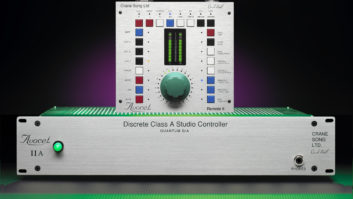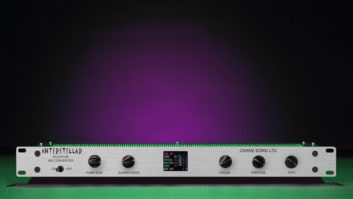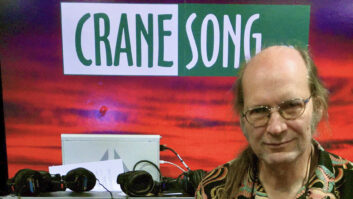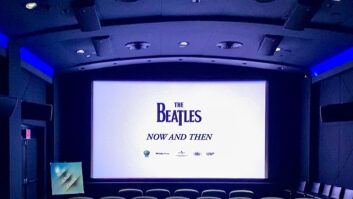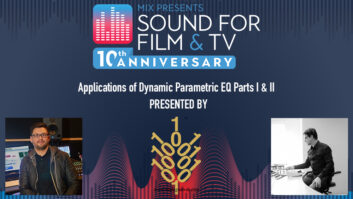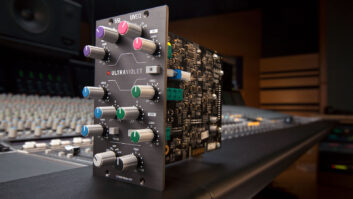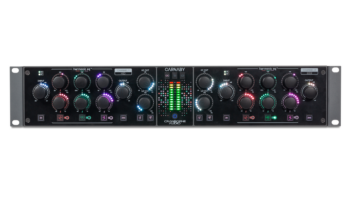
The discrete, Class-A, solid-state Crane Song Ibis ($4,500 list) embodies a new approach to the equalizer’s time-honored user interface and feature set. Many of the settings for the Ibis stepped frequency-selection switches are noted only as musical pitches (C#, F, etc.) in lieu of Hz and kHz markings. In addition, each of Ibis’ two channels sport independent color controls that add second- and third-harmonic distortion in varying degrees to either the full program or individual bands.
AN OVERVIEW
A quick scan of the 2U, rackmountable, beautiful front panel reveals two independent channels, each offering a low-cut filter and four widely overlapping bands of fully parametric EQ. Bands 1 and 4 can be switched to produce either bell curve or shelving response, while the two middle bands provide only bell curve filters. Each of the four bands provides 12 switched frequency settings by way of a rotary control. Half of these settings are notated as musical pitches, while the other half show both pitch and frequency markings (A = 440 Hz). When depressed, a red button below each frequency control raises all frequency settings in its associated band by a whole musical step, producing 12 additional frequency choices per band. A continuously variable gain control for each band provides up to 12 dB of boost or cut. Yet another continuously variable control for each band adjusts the bandwidth of the parametric filter’s response from 0.2 to four octaves. The bandwidth controls do not have an effect on shelving filters.
Each channel’s low-cut filter offers a choice of 11 fixed corner frequencies, ranging from 20 to 150 Hz (their corresponding musical pitches not noted) on a rotary control. A bypass setting is also provided in the control’s fully counterclockwise position. The low-cut filters slope can be switched to provide either a 12- or 24dB-per-octave roll-off.
Ibis’ analog color processing is different from that offered in the excellent all-digital Crane Song HEDD 192. A stepped, color source control for each channel selects which single frequency band will have color processing (second and third harmonics) added to its signal. Alternatively, color processing can be added to the program’s full bandwidth or bypassed completely. A continuously variable color control for each channel adjusts the amount of harmonics added to the original signal. When adding color in an isolated band, the amount of harmonics added is proportional to the amount of EQ boost or cut applied to that band. (When EQ cut is applied in a band, the color control adds harmonics in the opposite polarity relative to that of the program material.) Happily, you can add color to the program’s full bandwidth without applying boost or cut in any bands.
Balanced, floating cross-coupled XLRs (pin 2 hot) provide I/O connections on the rear panel. Each channel also sports a sidechain insert that is placed after the filters output, but before the sum of the filters. By inserting a compressor in the sidechain path, you could, for example, compress high frequencies when the EQ’d signal gets too bright. The sidechains’ DB15 connectors require custom cables.
Each of Ibis’ two channels can be independently bypassed, but there are no bypass switches provided for each band. Master output gain controls are also not provided, making unbiased A/B comparisons between unprocessed and equalized material problematic and downstream gain staging a hassle in certain applications. Furthermore, only Ibis’ frequency and color source controls have detents. (A mastering version, which lists for $8,000, provides stepped bandwidth and boost/cut controls, the latter adjustable over a ±6dB range in mostly 0.5dB increments.) Aside from a large power lamp, Ibis’ front panel does not have status indicators; no metering is provided on the unit. At the time of this writing, an owner’s manual was not available.
COLOR MY WORLD
Applied in moderation to individual synth, electric guitar and bass tracks in rock and pop productions, Ibis’ color controls added flattering grit. The ability to confine the addition of harmonics to a particular frequency band was a major plus. For example, I liked that I could deliberately add harmonics to only the low band on bass guitar, preventing the unwanted accentuation of higher frequencies.
Added generously to the full bandwidth of a snare drum track, the color option added flattering size and sizzle but rounded the instrument’s transient attack. I found it best, therefore, to feed the Ibis percussive material via an effect send or mult, preserving the dry signal, in applications where heavy color processing was desired.
Adding color only to the lowest band of a full mix resulted in a very subtle compression effect on the bottom end. I didn’t like adding color processing to the full bandwidth of a mix. To my ears, full-band color processing degraded the pristine elements of a mix by adding dirty-sounding distortion.
Ibis’ main strength lies not in its bells and whistles, but in its high-quality equalization. The EQ sounded clean, uncolored and very responsive. Considering the unit’s steep price tag, however, I’d like to see the Ibis offer more mission-critical features such as master output gain controls and independent bypasses for each band. But if musical note markings on equalizer filters present a more intuitive way for you to work, Ibis may be right for you.
Crane Song, 715/398-3627, www.cranesong.com.
Mix contributing editor Michael Cooper is the owner of Michael Cooper Recording in beautiful Sisters, Ore. Cooper’s studio offers recording, mixing and mastering services.
